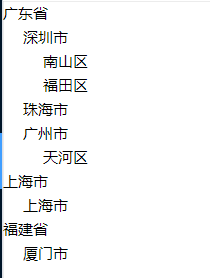js树状结构数据处理
使用了两个for循环,为了方便理解,可以理解为父亲找儿子,把儿子写入家族谱
// pid:父id,为0是最顶级数据,其他则对应每项的id,即父.id = 子.pid,则父.children = 子
interface Tree {
id: number
pid: number
name: string
}
let trees: Tree[] = [ { id: 1, pid: 0, name: '广东省' }, { id: 2, pid: 0, name: '上海市' }, { id: 3, pid: 0, name: '福建省' }, { id: 4, pid: 1, name: '深圳市' }, { id: 5, pid: 1, name: '珠海市' }, { id: 6, pid: 2, name: '上海市' }, { id: 7, pid: 3, name: '厦门市' }, { id: 8, pid: 1, name: '广州市' }, { id: 9, pid: 8, name: '天河区' }, { id: 10, pid: 4, name: '南山区' }, { id: 11, pid: 4, name: '福田区' } ] /** * 处理树状数据函数 * @param data 原始树状数据 * @return 处理后的树状数据 */ function getTrees(data: Tree[]) { // 父亲找儿子,把儿子写入家族谱 data.forEach((v: Tree) => { // v:儿子 arr.forEach((v1: Tree) => { // v1:父亲 if (v1.id === v.pid) { // 父亲找到儿子了,就添加到children if (!v1.children) v1.children = [] v1.children.push(v) } }) }) return data } let newTrees = getTrees(trees) let newArr = newTrees.filter((v) => v.pid === 0) // 筛选pid为0的数据,因为pid不为0的数据已经在pid为0的数据的子结构里面了 console.log(newArr)
html效果如下:






【推荐】国内首个AI IDE,深度理解中文开发场景,立即下载体验Trae
【推荐】编程新体验,更懂你的AI,立即体验豆包MarsCode编程助手
【推荐】抖音旗下AI助手豆包,你的智能百科全书,全免费不限次数
【推荐】轻量又高性能的 SSH 工具 IShell:AI 加持,快人一步
· TypeScript + Deepseek 打造卜卦网站:技术与玄学的结合
· 阿里巴巴 QwQ-32B真的超越了 DeepSeek R-1吗?
· 【译】Visual Studio 中新的强大生产力特性
· 【设计模式】告别冗长if-else语句:使用策略模式优化代码结构
· 10年+ .NET Coder 心语 ── 封装的思维:从隐藏、稳定开始理解其本质意义